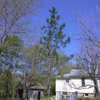Hole is a fir
whaas_5a
11 years ago
Related Stories

KITCHEN DESIGNKitchen of the Week: Salvage Meets High End in Vancouver
Reclaimed fir floors and a salvage-yard gate cozy up to choice appliances in a warm and sophisticated Canadian kitchen
Full Story
GARDENING GUIDESGarden Myths to Debunk as You Dig This Fall and Rest Over Winter
Termites hate wood mulch, don’t amend soil for trees, avoid gravel in planters — and more nuggets of garden wisdom
Full Story
HOLIDAYSHow to Care for Your Christmas Tree
Keep your tree looking lush until the last ornament is packed away with these tips for watering, using stands and more
Full Story
HOLIDAYSHouzz Call: Show Us Your Holiday Mantel
Do reindeer prance or lights dance above your fireplace during the holidays? Share your decorated mantel with us
Full Story
DECORATING GUIDESQuick Fix: Find Wall Studs Without an Expensive Stud Finder
See how to find hidden wall studs with this ridiculously easy trick
Full Story
EDIBLE GARDENSSummer Crops: How to Grow Tomatoes
Plant tomato seedlings in spring for one of the best tastes of summer, fresh from your backyard
Full Story
LIFEYou Showed Us: 20 Nutty Home Fixes
We made the call for your Band-Aid solutions around the house, and you delivered. Here's how you are making what's broken work again
Full Story
CHRISTMASReal vs. Fake: How to Choose the Right Christmas Tree
Pitting flexibility and ease against cost and the environment can leave anyone flummoxed. This Christmas tree breakdown can help
Full Story
MATERIALSAn Architect Shares His Go-To Materials
Aluminum doors, porcelain tiles, polished concrete. Here are the features and finishes this professional returns to time and again
Full Story
FARM YOUR YARDHow to Build a Raised Bed for Your Veggies and Plants
Whether you’re farming your parking strip or beautifying your backyard, a planting box you make yourself can come in mighty handy
Full Story





greenhaven
wisconsitom
Related Discussions
Can A White Fir grow in sand?
Q
Planting of concolor fir seedlings
Q
building fence near firs and cedars
Q
woodpecker damage to tree
Q
dcsteg
whaas_5aOriginal Author
ken_adrian Adrian MI cold Z5
gardener365
whaas_5aOriginal Author
alley_cat_gw_7b
whaas_5aOriginal Author
mmajicmann
tsugajunkie z5 SE WI ♱
whaas_5aOriginal Author
whaas_5aOriginal Author
dcsteg
botann
whaas_5aOriginal Author
greenhaven
dcsteg
wisconsitom
maple_grove_gw
whaas_5aOriginal Author
mmajicmann
whaas_5aOriginal Author
dcsteg
whaas_5aOriginal Author
wisconsitom
whaas_5aOriginal Author
tsugajunkie z5 SE WI ♱
dcsteg
greenhaven
greenhaven
Cher
dcsteg
severnside
whaas_5aOriginal Author
Cher
gardener365
Fiddlegal08
wisconsitom
dcsteg
wisconsitom